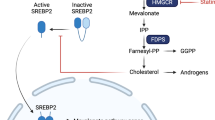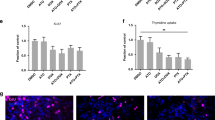Abstract
The 3-hydroxy-3-methylglutaryl coenzyme A (HMG-CoA) reductase inhibitors, also known as statins, are commonly prescribed medications that lower serum cholesterol and decrease cardiac morbidity and mortality. These agents inhibit the rate-limiting step of the mevalonate pathway, an effect that influences cholesterol homeostasis and other diverse cellular functions. Preclinical data suggest statins have pleiotropic antineoplastic effects in a variety of tumors, but clinical studies have provided conflicting data regarding whether statins may increase or decrease the risk of cancer. Abnormal cholesterol metabolism in cancer is poorly understood but should be considered when evaluating the antineoplastic effects of statins. Emerging evidence suggests that atherosclerosis and cancer have similar underlying molecular mechanisms, both having lipid abnormalities and a pro-inflammatory phenotype. Like nonsteroidal anti-inflammatory agents, statins target lipid metabolism, have significant anti-inflammatory effects, and can influence cardiovascular mortality. Recent studies show that statins may have chemopreventive effects and may complement cytotoxic chemotherapy or radiotherapy as a biologic response modifier in established cancer, but current data do not support their use as monotherapy. The preclinical data supporting anticancer activity, their additional health benefits, and the safety and relative low cost of statins compared to other 'targeted' agents currently under development all favor conducting prospective clinical trials of these drugs in cancer chemoprevention and therapy.
This is a preview of subscription content, access via your institution
Access options
Subscribe to this journal
Receive 12 print issues and online access
$209.00 per year
only $17.42 per issue
Buy this article
- Purchase on SpringerLink
- Instant access to full article PDF
Prices may be subject to local taxes which are calculated during checkout
Similar content being viewed by others
References
Alberts AW et al. (1980) Mevinolin: a highly potent competitive inhibitor of hydroxymethylglutaryl-coenzyme A reductase and a cholesterol-lowering agent. Proc Natl Acad Sci USA 77: 3957–3961
Downs JR et al. (2001) Air Force/Texas Coronary Atherosclerosis Prevention Study (AFCAPS/TexCAPS): additional perspectives on tolerability of long-term treatment with lovastatin. Am J Cardiol 87: 1074–1079
Heart Protection Study Collaborative Group (2002) MRC/BHF Heart Protection Study of cholesterol lowering with simvastatin in 20,536 high-risk individuals: a randomised placebo-controlled trial. Lancet 360: 7–22
The LIPID Study Group (Long-term Intervention with Pravastatin in Ischaemic Disease) (2002) Long-term effectiveness and safety of pravastatin in 9014 patients with coronary heart disease and average cholesterol concentrations: the LIPID trial follow-up. Lancet 359: 1379–1387
Sacks FM et al. (1996) The effect of pravastatin on coronary events after myocardial infarction in patients with average cholesterol levels. Cholesterol and Recurrent Events Trial Investigators. N Engl J Med 335: 1001–1009
Shepherd J et al. (1995) Prevention of coronary heart disease with pravastatin in men with hypercholesterolemia. West of Scotland Coronary Prevention Study Group. N Engl J Med 333: 1301–1307
Strandberg TE et al. (2004) Mortality and incidence of cancer during 10-year follow-up of the Scandinavian Simvastatin Survival Study (4S). Lancet 364: 771–777
Hebert PR et al. (1997) Cholesterol lowering with statin drugs, risk of stroke, and total mortality. An overview of randomized trials. JAMA 278: 313–321
Law MR et al. (2003) Quantifying effect of statins on low density lipoprotein cholesterol, ischaemic heart disease, and stroke: systematic review and meta-analysis. BMJ 326: 1423
Bjerre LM and LeLorier J (2001) Do statins cause cancer? A meta-analysis of large randomized clinical trials. Am J Med 110: 716–723
Pfeffer MA et al. (2002) Safety and tolerability of pravastatin in long-term clinical trials: prospective Pravastatin Pooling (PPP) Project. Circulation 105: 2341–2346
Boudreau DM et al. (2004) The association of 3-hydroxy-3-methylglutaryl coenzyme A inhibitor use and breast carcinoma risk in postmenopausal women: a case-control study. Cancer 100: 2038–2316
Graaf MR et al. (2004) The risk of cancer in users of statins. J Clin Oncol 22: 2388–2394
Poynter JN et al. (2004) HMG CoA reductase inhibitors and the risk of colorectal cancer. [abstract] Proc Am Soc Clin Oncol 22 (Suppl): S1
Brown MS and Goldstein JL (1980) Multivalent feedback regulation of HMG CoA reductase, a control mechanism coordinating isoprenoid synthesis and cell growth. J Lipid Res 21: 505–517
Goldstein JL and Brown MS (1990) Regulation of the mevalonate pathway. Nature 343: 425–430
Chan KK et al. (2003) The statins as anticancer agents. Clin Cancer Res 9: 10–19
Liao JK and Laufs U (2005) Pleiotropic effects of statins. Annu Rev Pharmacol Toxicol 45: 89–118
Wong WW et al. (2002) HMG-CoA reductase inhibitors and the malignant cell: the statin family of drugs as triggers of tumor-specific apoptosis. Leukemia 16: 508–519
Splichal JE et al. (2003) The statins: multifunctional antithrombotic and antineoplastic drugs. Semin Thromb Hemost 29: 259–274
Jakobisiak M and Golab J (2003) Potential antitumor effects of statins (review). Int J Oncol 23: 1055–1069
Weis M et al. (2002) Statins have biphasic effects on angiogenesis. Circulation 105: 739–745
Urbich C et al. (2002) Double-edged role of statins in angiogenesis signaling. Circ Res 90: 737–744
Sata M et al. (2004) Statins augment collateral growth in response to ischemia but they do not promote cancer and atherosclerosis. Hypertension 43: 1214–1220
Newman TB and Hulley SB (1996) Carcinogenicity of lipid-lowering drugs. JAMA 275: 55–60
Ederer F et al. (1971) Cancer among men on cholesterol-lowering diets. Lancet 2: 203–206
Coogan PF et al. (2002) Statin use and the risk of breast and prostate cancer. Epidemiology 13: 262–267
Barclay M et al. (1955) Human plasma lipoproteins, I. In normal women and in women with advanced carcinoma of the breast. Cancer 8: 253–260
Ho YK et al. (1978) Low-density lipoprotein (LDL) receptor activity in human acute myelogenous leukemia cells. Blood 52: 1099–1114
Kritz H et al. (1996) Low cholesterol and cancer. J Clin Oncol 14: 3043–3048
Kaye JA and Jick H (2004) Statin use and cancer risk in the General Practice Research Database. Br J Cancer 90: 635–637
Sharp SJ and Pocock SJ (1997) Time trends in serum cholesterol before cancer death. Epidemiology 8: 132–136
Libby P (2002) Inflammation in atherosclerosis. Nature 420: 868–874
Ridker PM et al. (1997) Inflammation, aspirin, and the risk of cardiovascular disease in apparently healthy men. N Engl J Med 336: 973–979
Ridker PM et al. (1998) Inflammation, pravastatin, and the risk of coronary events after myocardial infarction in patients with average cholesterol levels. Cholesterol and Recurrent Events (CARE) Investigators. Circulation 98: 839–844
Steinberg D (2002) Atherogenesis in perspective: hypercholesterolemia and inflammation as partners in crime. Nat Med 8: 1211–1217
Coussens LM and Werb Z (2002) Inflammation and cancer. Nature 420: 860–867
McMillan DC et al. (2001) Measurement of the systemic inflammatory response predicts cancer-specific and non-cancer survival in patients with cancer. Nutr Cancer 41: 64–69
Ross JS et al. (2001) Atherosclerosis and cancer: common molecular pathways of disease development and progression. Ann N Y Acad Sci 947: 271–292
Thun MJ et al. (2002) Nonsteroidal anti-inflammatory drugs as anticancer agents: mechanistic, pharmacologic, and clinical issues. J Natl Cancer Inst 94: 252–266
Olsen JH et al. (1999) Lipid-lowering medications and risk of cancer. J Clin Epidemiol 52: 167–169
Blais L et al. (2000) 3-Hydroxy-3-methylglutaryl coenzyme A reductase inhibitors and the risk of cancer: a nested case-control study. Arch Intern Med 160: 2363–2368
Beck P et al. (2003) Statin use and risk of breast cancer. J Clin Epidemiol 56: 280–285
Cauley JA et al. (2003) Lipid-lowering drug use and breast cancer in older women: a prospective study. J Women's Health (Larchmt) 12: 749–756
Holly EA et al. (1999) Case-control study of non-Hodgkin's lymphoma among women and heterosexual men in the San Francisco Bay Area, California. Am J Epidemiol 150: 375–389
Zhang Y et al. (2004) Prior medical conditions and medication use and risk of non-Hodgkin lymphoma in Connecticut United States women. Cancer Causes Control 15: 419–428
Holly EA and Bracci PM (2003) Population-based study of non-Hodgkin lymphoma, histology, and medical history among human immunodeficiency virus-negative participants in San Francisco. Am J Epidemiol 158: 316–327
Thibault A et al. (1996) Phase I study of lovastatin, an inhibitor of the mevalonate pathway, in patients with cancer. Clin Cancer Res 2: 483–491
Kim WS et al. (2001) Phase II study of high-dose lovastatin in patients with advanced gastric adenocarcinoma. Invest New Drugs 19: 81–83
Lopez-Aguilar E et al. (1999) Security and maximal tolerated doses of fluvastatin in pediatric cancer patients. Arch Med Res 30: 128–131
Katz M et al. (2003) Statin use is associated with improved biochemical outcome after high-dose radiotherapy for prostate cancer. [abstract] Int J Radiat Oncol Biol Phys 57: S271
Katz MS et al. Association of statin use with a pathologic complete response to neoadjuvant chemoradiation for rectal cancer. Int J Radiat Oncol Biol Phys, in press
Kawata S et al. (2001) Effect of pravastatin on survival in patients with advanced hepatocellular carcinoma. A randomized controlled trial. Br J Cancer 84: 886–891
Larner J et al. (1998) A phase I-II trial of lovastatin for anaplastic astrocytoma and glioblastoma multiforme. Am J Clin Oncol 21: 579–583
Jain RK (1994) Barriers to drug delivery in solid tumors. Sci Am 271: 58–65
Folkman J (1995) Angiogenesis in cancer, vascular, rheumatoid and other disease. Nat Med 1: 27–31
Almog Y et al. (2004) Prior statin therapy is associated with a decreased rate of severe sepsis. Circulation 110: 880–885
del Real G et al. (2004) Statins inhibit HIV-1 infection by down-regulating Rho activity. J Exp Med 200: 541–547
Vaughan CJ (2003) Prevention of stroke and dementia with statins: effects beyond lipid lowering. Am J Cardiol 91: 23B–29B
Vollmer T et al. (2004) Oral simvastatin treatment in relapsing-remitting multiple sclerosis. Lancet 363: 1607–1608
Acknowledgements
The author expresses gratitude to Drs Jay Loeffler, Guido Majno, and Michael Zelefsky for their support and valuable insight.
Author information
Authors and Affiliations
Ethics declarations
Competing interests
The author declares no competing financial interests.
Glossary
- AFCAPS/TEXCAPS
-
Air Force/Texas Coronary Atherosclerosis Prevention Study
Rights and permissions
About this article
Cite this article
Katz, M. Therapy Insight: potential of statins for cancer chemoprevention and therapy. Nat Rev Clin Oncol 2, 82–89 (2005). https://doi.org/10.1038/ncponc0097
Received:
Accepted:
Issue Date:
DOI: https://doi.org/10.1038/ncponc0097



